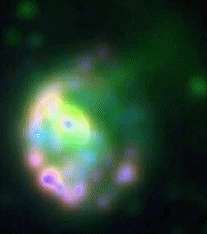Ultra-luminous x-ray sources

(PhysOrg.com) -- An ultra-luminous X-ray source (ULX) emits more radiation in the X-rays than do a million suns at all wavelengths. ULXs are rare: Most galaxies, including our own Milky Way, have none, and galaxies that do host a ULX usually have only one. ULXs are also mysterious: If they were stars with about the mass of the sun, their huge luminosities should tear them apart. Most astronomers today think that ULXs are black holes of more than about ten solar-masses that are accreting material onto a disk, and emitting their X-rays in a beam. When there is beaming towards us, the total luminosity is much less than we would infer from our measurements than if the emission were in all directions. This explanation helps understand the physics of ULXs, but their origins are still obscure.
Stellar mass black holes are made in the explosive deaths of massive stars. Because astronomers believe it is easier to make massive black holes from stars that are deficient in elements heavier than helium, they suspect that ULXs are more likely to be present in galaxies deficient in these elements. Several years ago, twelve ULXs - a record number - were indeed found in an element-deficient galaxy, lending support to this model. But that galaxy had other peculiarities as well. It had recently suffered a collision that knocked its inner nuclear region away, leaving just the outer galaxy behind in the form of a ring. Maybe the collision that produced the ring also helped to spawn the ULXs?
To find out, CfA astronomers Andrea Prestwich, Jose Galache, and Andreas Zezas, with six colleagues, observed the ring galaxy NGC 922 with the Chandra X-ray Observatory. They scientists found that this ring galaxy also had an abundance of ULXs: seven of them. But NGC 922 is not deficient in heavy elements. The team concludes that, at least in these two objects, the heavy element abundance is not a factor. Moreover, they find that the relative number of ULXs in the two galaxies scales with their relative star formation rates. The team has undertaken a larger survey of element-deficient galaxies in an effort to probe the phenomenon more widely, but the new results are an important first step.
Provided by Harvard-Smithsonian Center for Astrophysics





















